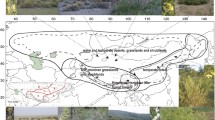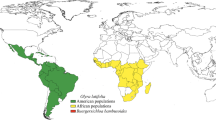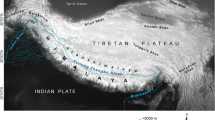Abstract
Caragana, a leguminous genus mainly restricted to temperate Central and East Asia, occurs in arid, semiarid, and humid belts, and has forest, grassland, and desert ecotypes. Based on the previous molecular phylogenetic tree and dating, biogeographical analyses of extant species area and ecotype were conducted by means of four ancestral optimization approaches: S-DIVA, Lagrange, Mesquite, and BBM. The results indicate the ancestral attributes of Caragana as an arid origin from the Junggar Basin and arid belt of climate and vegetation in the middle Miocene. The ancestral ecotype was most likely adapted to steppe habitats. Uplift and expansion of the Qinghai-Xizang (Tibet) Plateau (QTP) and retreat of the Paratethys Sea are believed to have led to this origin, and also the subsequent diversification and adaptive radiation in the genus. The direction of radiation is suggested in brief to have been from the Central Asian Junggar to East Asia and Tibet.




Similar content being viewed by others
References
An ZS, Kutzbach JE, Prell WL, Port SC (2001) Evolution of Asian monsoons and phased uplift of the Himalaya-Tibetan plateau since Late Miocene times. Nature 411:62–66
Antonellia A, Nylanderb AAJ, Perssona C, Sanmartin I (2009) Tracing the impact of the Andean uplift on Neotropical plant evolution. Proc Natl Acad Sci USA 106:9749–9754
Bendiksby M, Schumacher T, Gussarova G, Nais J, Mat-Salleh K, Sofiyanti N, Madulid D, Smith SA, Barkman T (2010) Elucidating the evolutionary history of the Southeast Asian, holoparasitic, giant-flowered Rafflesiaceae: pliocene vicariance, morphological convergence and character displacement. Molec Phylogenet Evol 57:620–633
Bytebier B, Antonelli A, Bellstedt DU et al (2011) Estimating the age of fire in the Cape flora of South Africa from an orchid phylogeny. Proc Roy Soc London, Ser B, Biol Sci 278(1703):188–195
Coleman M, Hodges K (1995) Evidence for Tibetan Plateau uplift before 14 Myr age from new minimum estimate for east–west extension. Nature 374:49–52
Couvreur TLP, Pirie MD, Chatrou LW, Richard M, Saunders K, Yvonne CFSu, Richardson JM, Erkens RHJ (2011) Early evolutionary history of the flowering plant family Annonaceae: steady diversification and boreotropical geodispersal. J Biogeogr 38:664–680
Emadzade K, Horandl E (2011) Northern Hemisphere origin, transoceanic dispersal, and diversification of Ranunculeae DC. (Ranunculaceae) in the Cenozoic. J Biogeogr 38:517–530
Givnish TJ, Systma KJ (1997) Molecular evolution and adaptive radiation. Cambridge University Press, NY
Glor RE (2010) Phylogenetic insights on adaptive radiation. Annual Rev Ecol Evol Syst 41:251–270
Greve C, Hutterer R, Groh K, Haase M, Misof B (2010) Evolutionary diversification of the genus Theba (Gastropoda: Helicidae) in space and time: a land snail conquering islands and continents. Molec Phylogenet Evol 57:572–584
Grubov VI (1999) Plants of Central Asia, vol 1. Science Publishers, New Hampshire
Guo SX (1983) Note on phytogeographic provinces and ecological environment of Late Cretaceous and Tertiary floras in China. In: Lu YH (ed) Palaeobiogeographic provinces of China. Science Press, Beijing, pp 164–177
Guo ZT, Sun B, Zhang ZS, Peng SZ, Xiao GQ, Ge JY, Hao QZ, Qiao YS, Liang MY, Liu JF, Yin QZ, Wei JJ (2008) A major reorganization of Asian climate by the early Miocene. Climate Past 4:153–174
Gussarova G, Popp M, Vitek E, Brochmann C (2008) Molecular phylogeny and biogeography of the bipolar Euphrasia (Orobanchaceae): recent radiations in an old genus. Molec Phylogenet Evol 48:444–460
Harris N (2006) The elevation history of the Tibetan Plateau and its implications for the Asian monsoon. Palaeogeogr Palaeoclimatol Palaeoecol 241:4–15
Hrbek T, Meyer A (2003) Closing of the tethys sea and the phylogeny of Eurasian killifishes (Cyprinodontiformes: Cyprinodontidae). J Evol Biol 16:17–36
Komarov VL (1908) Generis Caragana monographia. Acta Horti Petrop 29:179–388
Komarov VL (1947) VL Komarov Opera selecta. Academic Science URSS, Moscow, pp 159–342
Lavergne S, Mouquet N, Thuiller W, Ronce O (2010) Biodiversity and climate change: integrating evolutionary and ecological responses of species and communities. Annual Rev Ecol Evol Syst 41:321–350
Li JJ, Fang XM (1998) Research on the uplift of the Qinghai-Xizang Plateau and environmental changes. China Sci Bull 43:1569–1574
Li GJ, Petke T, Chen J (2011) Increasing Nd isotopic ratio of Asian dust indicates progressive uplift of the north Tibetan Plateau since the middle Miocene. Geology 39:199–202
Linder PH (2008) Plant species radiations: where, when, why? Philos Trans, Ser B 363:3097–3105
Liu YX, Chang ZY, Yakolev GP (2010) Caragana. In: Wu ZY, Raven PH (eds) Flora of China, vol 10. Science Press, Beijing and Missouri Botanical Garden Press, St. Louis
Maddison WP, Maddison DR (2009) MESQUITE: a modular system for evolutionary analysis. Version 2.6. Available at: http://mesquiteproject.org
Moore RJ (1968) Chromosome numbers and phylogeny in Caragana (Leguminosae). Canad J Bot 46:1513–1522
Morley RJ (2003) Interplate dispersal paths for megathermal angiosperms. Perspect Pl Ecol Evol Syst 6:5–20
Nylander JAA, Olsson U, Alström P et al (2008) Accounting for phylogenetic uncertainty in biogeography: a Bayesian approach to dispersal–vicariance analysis of the thrushes (Aves: Turdus). Syst Biol 57:257–268
Pepper M, Fujita MK, Moritz C, Keogh JS (2011) Palaeoclimate change drove diversification among isolated mountain refugia in the Australian arid zone. Molec Ecol 20:1529–1545
Quade J, Cerling TE, Bowman JR (1989) Development of Asian monsoon revealed by marked ecological shift during the latest Miocene in northern Pakistan. Nature 342:163–165
Ramstein G, Fluteau F, Besse J, Joussaume S (1997) Effect of orogeny, plate motion and land–sea distribution on Eurasian climate change over the past 30 million years. Nature 386:788–795
Ree RH, Smith SA (2008) Maximum likelihood inference of geographic range evolution by dispersal, local extinction, and cladogenesis. Syst Biol 57:4–14
Ronquist F (2004) Bayesian inference of character evolution. Trends Ecol Evol 19:475–481
Sanchir C (1979) Genus Caragana Lam., systematics, geography, phylogeny and economic significance in study on flora and vegetation of P. R. Mongolia, vol 1. Academic Press, Ulan Bator
Sanderson MJ (1998) Reappraising adaptive radiation. Amer J Bot 85:1650–1655
Sarnat EM, Moreau CS (2011) Biogeography and morphological evolution in a Pacific island ant radiation. Molec Ecol 20:114–130
Shi YF, Tang MC, Ma YZ (1998) The relation of second rising in Qinghai-Xizang Plateau and Asia Monsoon. Sci China D 28:263–271
Shi YF, Li JJ, Li BY, Yao TD, Wang SM, Li SJ, Cui ZJ, Wang FB, Pan BT, Fang XM, Zhang QS (1999) Uplift of the Qinghai-Xizang (Tibetan) Plateau and East Asia environmental change during late Cenozoic. Acta Geogr Sin 54:10–21
Song ZC, Li HM, Zheng YH, Liu GW (1983) Miocene floristic regions of China. In: Lu YH (ed) Palaeobiogeographic provinces of China. Science Press, Beijing, pp 178–184
Spalik K, Piwczynski M, Danderson CA, Kurzyna-Młynik R, Bone TS, Downie SR (2010) Amphitropic amphiantarctic disjunctions in Apiaceae subfamily Apioideae. J Biogeogr 37:1977–1994
Tao JR (1992) The Tertiary vegetation and flora and floristic regions in China. Acta Phytotax Sin 31:25–43
Thiv M, Thulin M, Hjertson M, Kropf M, Linder HP (2010) Evidence for a vicariant origin of Macaronesian–Eritreo/Arabian disjunctions in Campylanthus Roth (Plantaginaceae). Molec Phylogenet Evol 54:607–616
Willis KJ, McElwain JC (2002) The evolution of plants. Oxford University Press, Oxford
Winkler IS, Mitter C, Scheffer SJ (2009) Repeated climate-linked host shifts have promoted diversification in a temperate clade of leaf-mining flies. Proc Natl Acad Sci 106:18103–18108
Wu ZY (ed) (1980) Vegetation of China. Science Press, Beijing
Wu ZY, Wu SG (1998) A proposal for new floristic kingdom (realm)—the E. Asiatic kingdom, its delimitation and characteristics. In: Zhang AL, Wu SG (eds) Floristic characteristics and diversity of Eastern Asian Plants. China Higher Education Press, Beijing and Springer-Verlag, Hongkong
Xiang XG, Wang W, Li RQ et al (2014) Large-scale phylogenetic analyses reveal fagalean diversification promoted by the interplay of diaspores and environments in the Paleogene. Perspect Pl Ecol Evol Syst 16:101–110
Yu Y, Harris AJ, He X (2010) S-DIVA (Statistical Dispersal–Vicariance Analysis): a tool for inferring biogeographic histories. Molec Phylogenet Evol 56:848–850
Zhang ML (1997a) The geographic distribution of the genus Caragana in Qinghai-Xizang Plateau and Himalayas. Acta Phytotax Sin 35:136–147
Zhang ML (1997b) A reconstructing phylogeny in Caragana (Fabaceae). Acta Bot Yunnan 19:331–341
Zhang ML (1998) A preliminary analytic biogeography in Caragana (Fabaceae). Acta Bot Yunnan 20:1–11
Zhang ML (2004) Ancestral area analysis of the genus Caragana (Leguminosae). Acta Bot Sin 46:253–258
Zhang ML (2005) A dispersal and vicariance analysis of the genus Caragana Fabr. J Integr Pl Biol 47:897–904
Zhang ML, Fritsch PW (2010) Evolutionary response of Caragana (Fabaceae) to Qinghai-Tibetan Plateau uplift and Asian interior aridification. Pl Syst Evol 288:191–199
Zhang ZS, Wang HJ, Guo ZT, Jiang DB (2007) What triggers the transition of palaeoenvironmental patterns in China, the Tibetan Plateau uplift or the Paratethys Sea retreat? Palaeogeogr Palaeoclimatol Palaeoecol 245:317–331
Zhang ML, Fritsch PW, Cruz BC (2009) Phylogeny of Caragana (Fabaceae) based on DNA sequence data from rbcL, trnS–trnG, and ITS. Molec Phylogenet Evol 50:547–559
Zhao YZ (1993) Taxonomic study of the genus Caragana from China. Acta Sci Nat Univ Inner Mongolia 24:631–653
Zhao YZ (2008) Classification and floristic geography of Caragana Fabr. in the world. Inner Mongolia University Press, Hohot
Zhong DL, Ding L (1996) The uplifting process and mechanism of Qinghai-Xizang (Tibet) Plateau. Sci China D 26:289–295
Zubakov VA, Borzenkova II (1990) Global palaeoclimate of the Late Cenozoic. Elsevier, Amsterdam
Acknowledgments
We are grateful to two anonymous reviewers and editor-in-chief Prof. Marcus Koch for their valuable comments for improving the manuscript. Funding was provided by China National Key Basic Research Program (2012FY111500, 2014CB954201), and Xinjiang Institute of Ecology and Geography, Chinese Academy of Sciences.
Author information
Authors and Affiliations
Corresponding author
Additional information
Handling editor: Yunpeng Zhao.
Rights and permissions
About this article
Cite this article
Zhang, M., Xue, J., Zhang, Q. et al. Inferring ancestral distribution area and survival vegetation of Caragana (Fabaceae) in Tertiary. Plant Syst Evol 301, 1831–1842 (2015). https://doi.org/10.1007/s00606-015-1196-z
Received:
Accepted:
Published:
Issue Date:
DOI: https://doi.org/10.1007/s00606-015-1196-z




